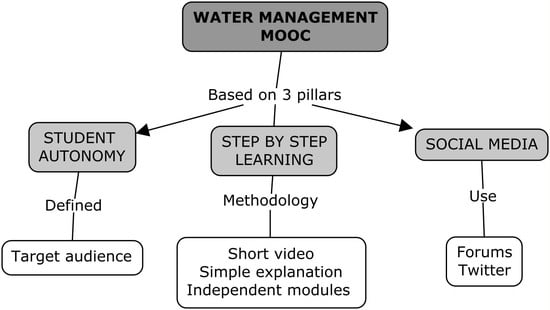Learning Design Decisions in Massive Open Online Courses (MOOC) Applied to Higher Education in Civil-Engineering Topics
Abstract
1. Introduction
2. MOOC Learning Design
2.1. Objective and Didactic Methodology
- Student Autonomy: The students’ learning is based on prior knowledge and autonomy, where defining the target audience is particularly highlighted. The MOOC was preferentially developed for students or graduates in civil engineering, environmental engineering, or related careers to urban water-cycle management to facilitate its correct understanding in an autonomous manner.
- Direct and Progressive Lessons: The master class must be short, simple, and straightforward. The structure of the MOOC, consisting of short videos and independent modules, enables autonomous and step-by-step learning in such a way that the acquisition of knowledge is progressive, from the global to the more technical aspects.
- Social Support: Social support and communication (instructor–student and student–student) were promoted in forums of the online training platform. The forums were a support to add complementary information, to open topics for discussion, and to share appreciation or resolve issues about MOOC matters.
2.2. Sequencing, Resources, and Teaching Materials
- Module I: Introduction to urban water-cycle management. Water Framework Directive. Social and legislative contextualization of urban water-cycle management.
- Module II. Urban wastewater treatment. Description and parameters. Presentation of a conventional wastewater-treatment plant (WWTP).
- Module III. Wastewater-treatment plants. Water lines. Study of water lines, global schemes, and treatments of a WWTP.
- Module IV. Wastewater-treatment plants. Sludge lines. Study of sludge lines, global schemes, and treatments of a WWTP.
- Module V. Nonconventional debugging techniques. Development of unconventional debugging techniques and methods. Advantages and disadvantages.
3. Materials and Methods
3.1. Sociodemographic Characteristics of Respondent Participants
3.2. Instruments
4. Results and Discussion
4.1. Previous Interests
4.2. Satisfaction Rates
4.3. Social-Media Interactions
5. Conclusions
- (1)
- The importance of the establishment of a target audience to whom the course is directed. As other studies indicated [19,20], prior knowledge is crucial to completing a specific MOOC. Without prejudice to its open character, graduate and university students who want professional improvement are the target group.
- (2)
- Students value a course design that promotes autonomous learning combined with social support.
- (3)
Author Contributions
Funding
Acknowledgments
Conflicts of Interest
References
- Griggs, D.; Stafford-Smith, M.; Gaffney, O.; Rockström, J.; Öhman, M.C.; Shyamsundar, P.; Steffen, W.; Glaser, G.; Kanie, N.; Noble, I. Sustainable development goals for people and planet. Nature 2013, 495, 305. [Google Scholar] [CrossRef] [PubMed]
- Jenerette, G.D.; Larsen, L. A global perspective on changing sustainable urban water supplies. Glob. Planet. Chang. 2006, 50, 202–211. [Google Scholar] [CrossRef]
- UN Goal 6 | Sustainable Development Knowledge Platform. Available online: https://sustainabledevelopment.un.org/sdg6 (accessed on 19 March 2019).
- Goal 4 | Department of Economic and Social Affairs. Available online: https://sdgs.un.org/goals/goal4 (accessed on 30 July 2020).
- Sharples, M. The design of personal mobile technologies for lifelong learning. Comput. Educ. 2000, 34, 177–193. [Google Scholar] [CrossRef]
- Daradoumis, T.; Bassi, R.; Xhafa, F.; Caballé, S. A Review on Massive E-Learning (MOOC) Design, Delivery and Assessment. In Proceedings of the 2013 Eighth International Conference on P2P, Parallel, Grid, Cloud and Internet Computing, Compiegne, France, 28–30 October 2013; pp. 208–213. [Google Scholar]
- Glance, D.G.; Forsey, M.; Riley, M. The pedagogical foundations of massive open online courses. First Monday 2013, 18. [Google Scholar] [CrossRef]
- Trajkovic, S.; Cvetković, D.; Radivojević, V. Mooc as an Instrument of Informal and Lifelong Learning. In Sinteza 2016-International Scientific Conference on ICT and E-Business Related Research; Singidunum University: Belgrad, Serbia, 2016; p. 286. [Google Scholar]
- Li, C.; Zhou, H. Enhancing the Efficiency of Massive Online Learning by Integrating Intelligent Analysis into MOOCs with an Application to Education of Sustainability. Sustainability 2018, 10, 468. [Google Scholar] [CrossRef]
- Aldowah, H.; Al-Samarraie, H.; Alzahrani, A.I.; Alalwan, N. Factors affecting student dropout in MOOCs: A cause and effect decision-making model. J. Comput. High Educ. 2020, 32, 429–454. [Google Scholar] [CrossRef]
- Ruiz-Palmero, J.; López-Álvarez, D.; Sánchez-Rivas, E.; Sánchez-Rodríguez, J. An Analysis of the Profiles and the Opinion of Students Enrolled on xMOOCs at the University of Málaga. Sustainability 2019, 11, 6910. [Google Scholar] [CrossRef]
- Zhan, Z.; Fong, P.; Mei, H.; Chang, X.; Liang, T.; Ma, Z. Sustainability Education in Massive Open Online Courses: A Content Analysis Approach. Sustainability 2015, 7, 2274–2300. [Google Scholar] [CrossRef]
- Guo, P.J.; Kim, J.; Rubin, R. How video production affects student engagement: An empirical study of MOOC videos. In Proceedings of the First ACM Conference on Learning @ Scale Conference—L@S ’14, Atlanta, GA, USA, 4–5 March 2014; pp. 41–50. [Google Scholar]
- Park, J.-H.; Choi, H.J. Factors Influencing Adult Learners’ Decision to Drop Out or Persist in Online Learning. J. Educ. Technol. Soc. 2009, 12, 207–217. [Google Scholar]
- Panigrahi, R.; Srivastava, P.R. Understanding the motivation in massive open online courses: A Twitter mining perspective. Int. J. Web Based Communities 2018, 14, 228–248. [Google Scholar] [CrossRef]
- Jiang, S.; Kotzias, D. Assessing the Use of Social Media in Massive Open. Available online: https://arxiv.org/ftp/arxiv/papers/1608/1608.05668.pdf (accessed on 10 October 2020).
- UEX Cursos MOOC—Portal de la UEX—Bienvenido a la Universidad de Extremadura. Available online: https://www.unex.es/organizacion/gobierno/vicerrectorados/vicentpi/estructura/mooc (accessed on 28 July 2020).
- Miríadax Gestión del Agua: Introducción al Tratamiento de Aguas Residuales (3.a Edición). Available online: https://miriadax.net/web/web/gestion-del-agua-introduccion-al-tratamiento-de-aguas-residuales-3-edicion- (accessed on 28 July 2020).
- Kennedy, G.; Coffrin, C.; Corrin, L. Predicting success: How learners’ prior knowledge, skills and activities predict MOOC performance. In Proceedings of the Fifth International Conference on Learning Analytics and Knowledge, Poughkeepsie, NY, USA, 16–20 March 2015; 2015; pp. 136–140. [Google Scholar] [CrossRef]
- Lee, Y.; Choi, J. A review of online course dropout research: Implications for practice and future research. Educ. Tech Res. Dev 2011, 59, 593–618. [Google Scholar] [CrossRef]
- Ho, A.D.; Chuang, I.; Reich, J.; Coleman, C.A.; Whitehill, J.; Northcutt, C.G.; Williams, J.J.; Hansen, J.D.; Lopez, G.; Petersen, R. HarvardX and MITx: Two Years of Open Online Courses Fall 2012–Summer 2014. SSRN J. 2015. [Google Scholar] [CrossRef]
- Rivas, E.S.; Álvarez, D.L.; Vega, E.S.; Abanza, A.; Palmero, J.R. ¿Qué Sabemos de los Estudiantes de los MOOC? Un Estudio de Caso; Universidad de Granada: Granada, Spain, 2018; p. 16. [Google Scholar]
- Bralić, A.; Divjak, B. Integrating MOOCs in traditionally taught courses: Achieving learning outcomes with blended learning. Int. J. Educ. Technol. High. Educ. 2018, 15, 2. [Google Scholar] [CrossRef]
- Twitter Analytics. Available online: https://analytics.twitter.com (accessed on 30 July 2020).
- Valverde-Berrocoso, J.; Arroyo, M.d.G.; Burgos-Videla, C.; Morales-Cevallos, M.B. Trends in Educational Research about e-Learning: A Systematic Literature Review (2009–2018). Sustainability 2020, 12, 5153. [Google Scholar] [CrossRef]
- Shen, C.; Kuo, C.-J. Learning in massive open online courses: Evidence from social media mining. Comput. Hum. Behav. 2015, 51, 568–577. [Google Scholar] [CrossRef]
- Castaño-Garrido, C.; Maiz-Olazabalaga, I.; Garay-Ruiz, U. Design, Motivation and Performance in a Cooperative MOOC Course. Comun. Rev. Científica Comun. Educ. 2015, 22, 19–26. [Google Scholar] [CrossRef]
- Islam, M.F.; Akter, T.; Knezevic, R. The Role of Moocs in Achieving the Sustainable Development Goal Four; Limerick Institute of Technology: Limerick, Ireland, 2019; p. 15. [Google Scholar]
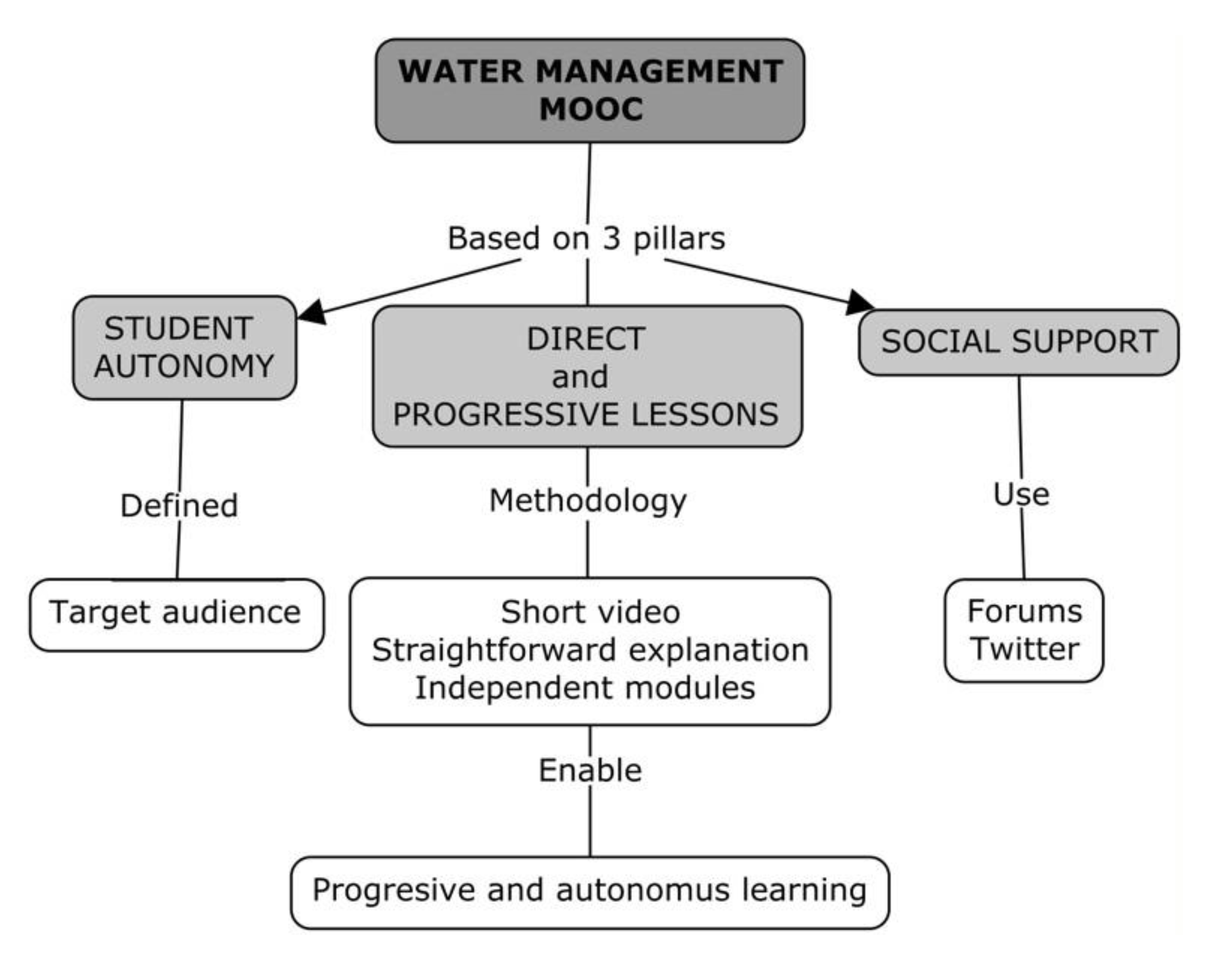
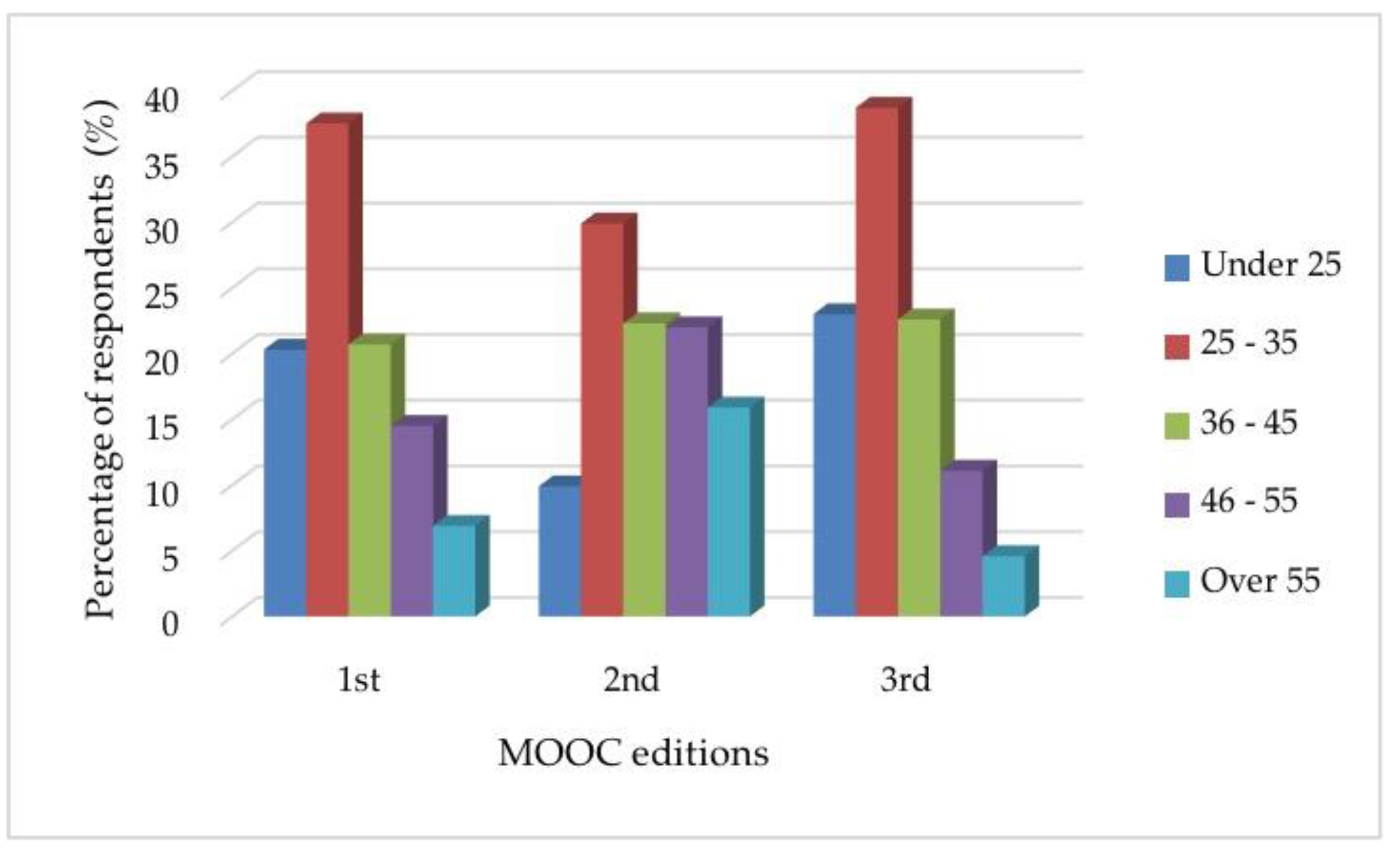
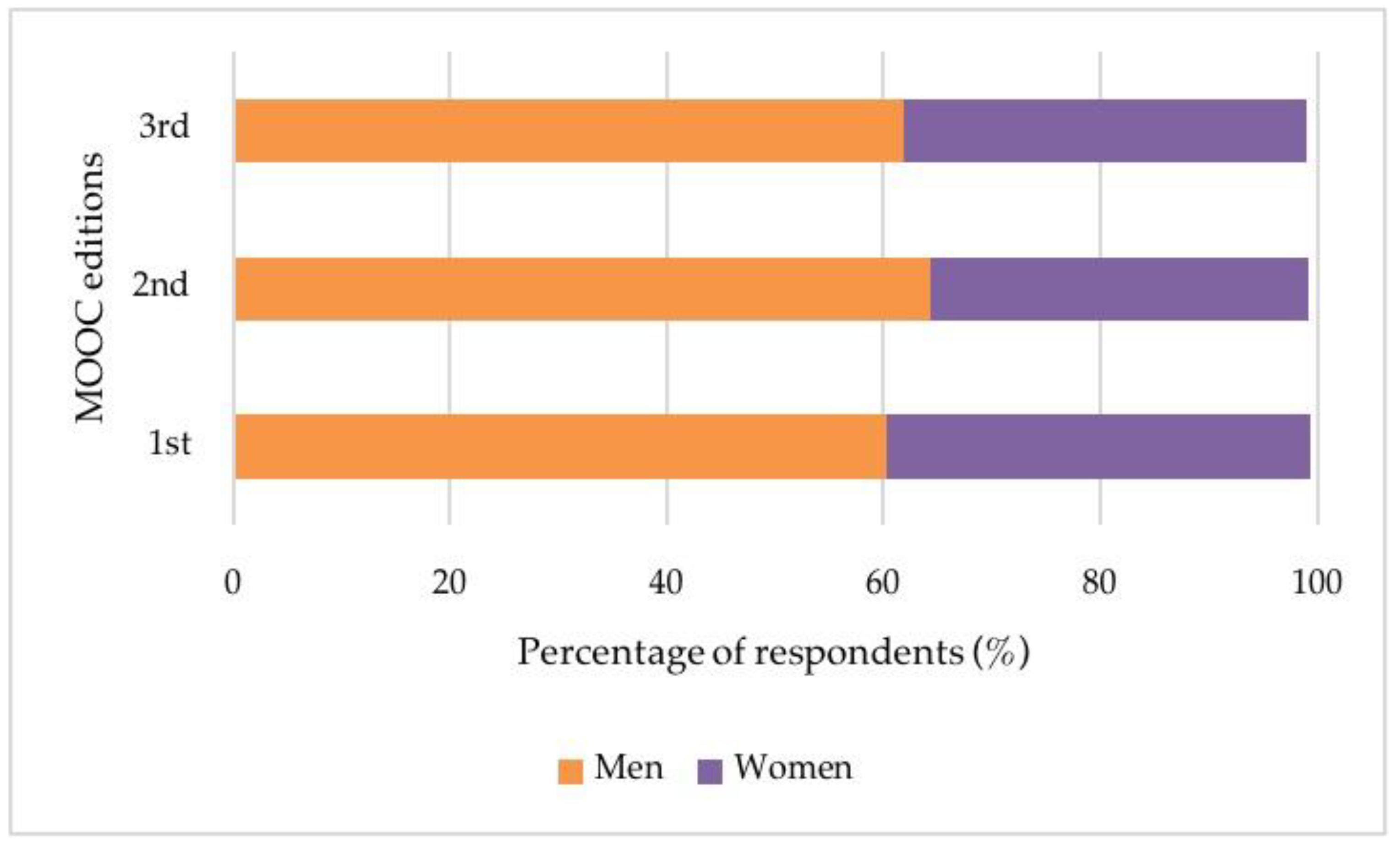
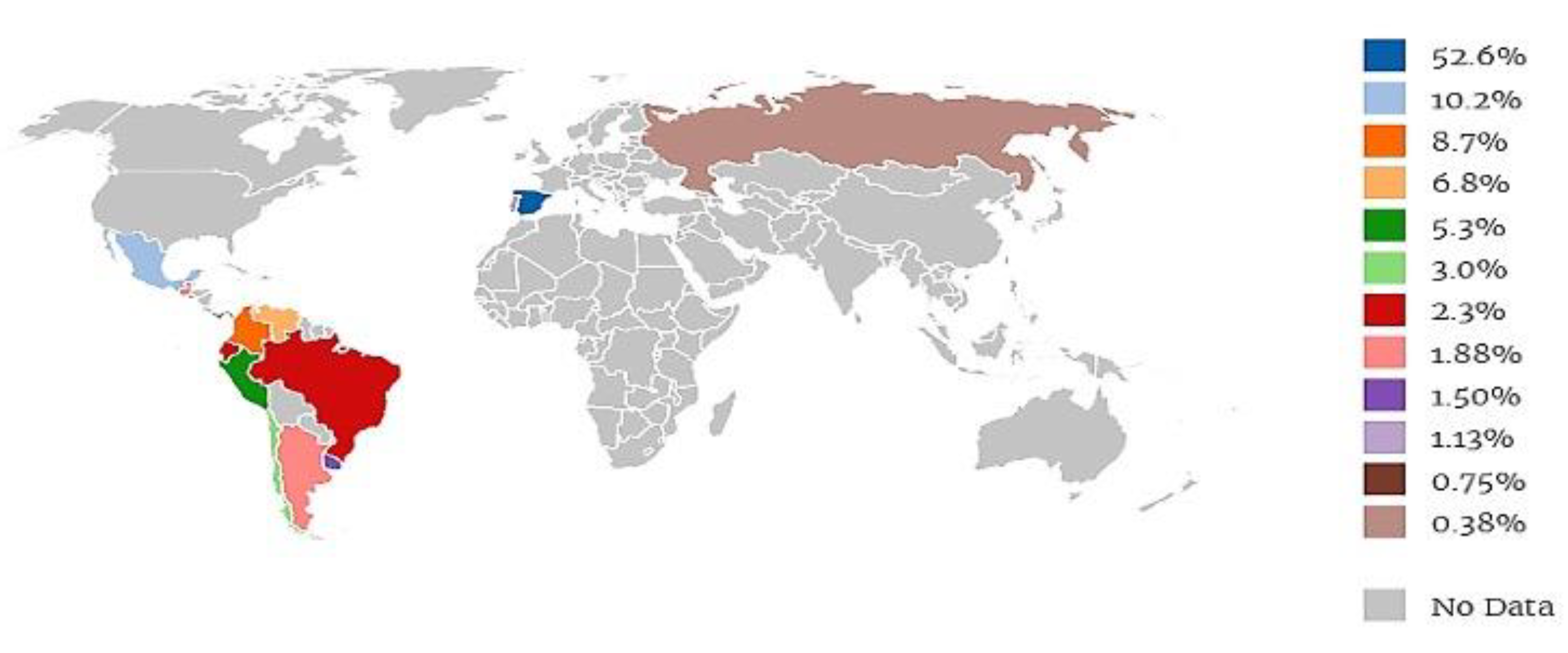
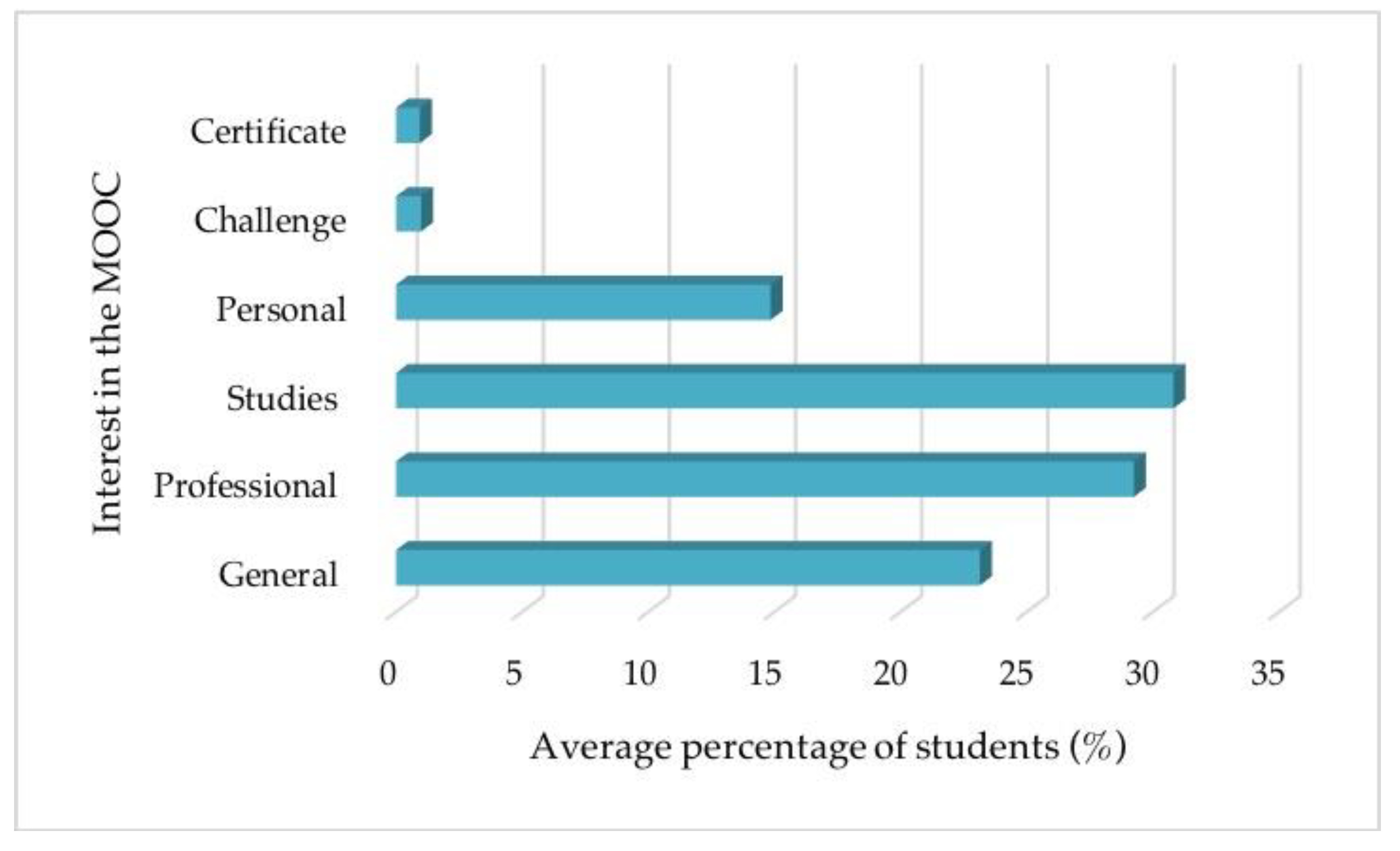
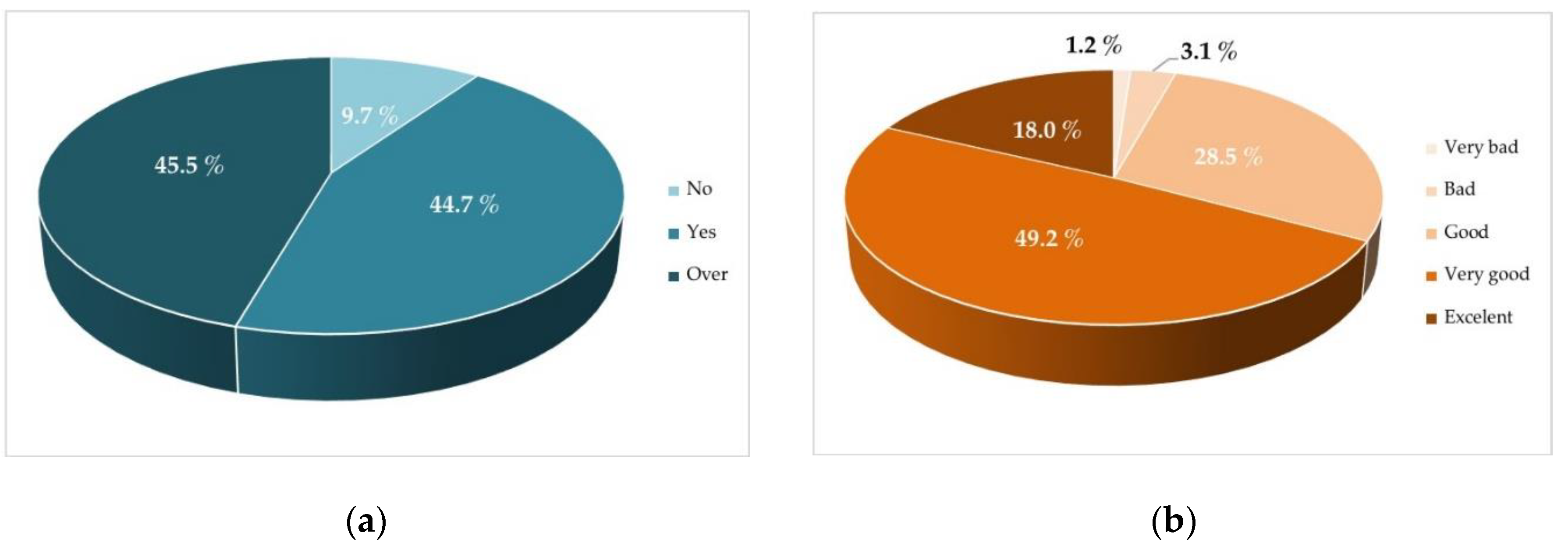
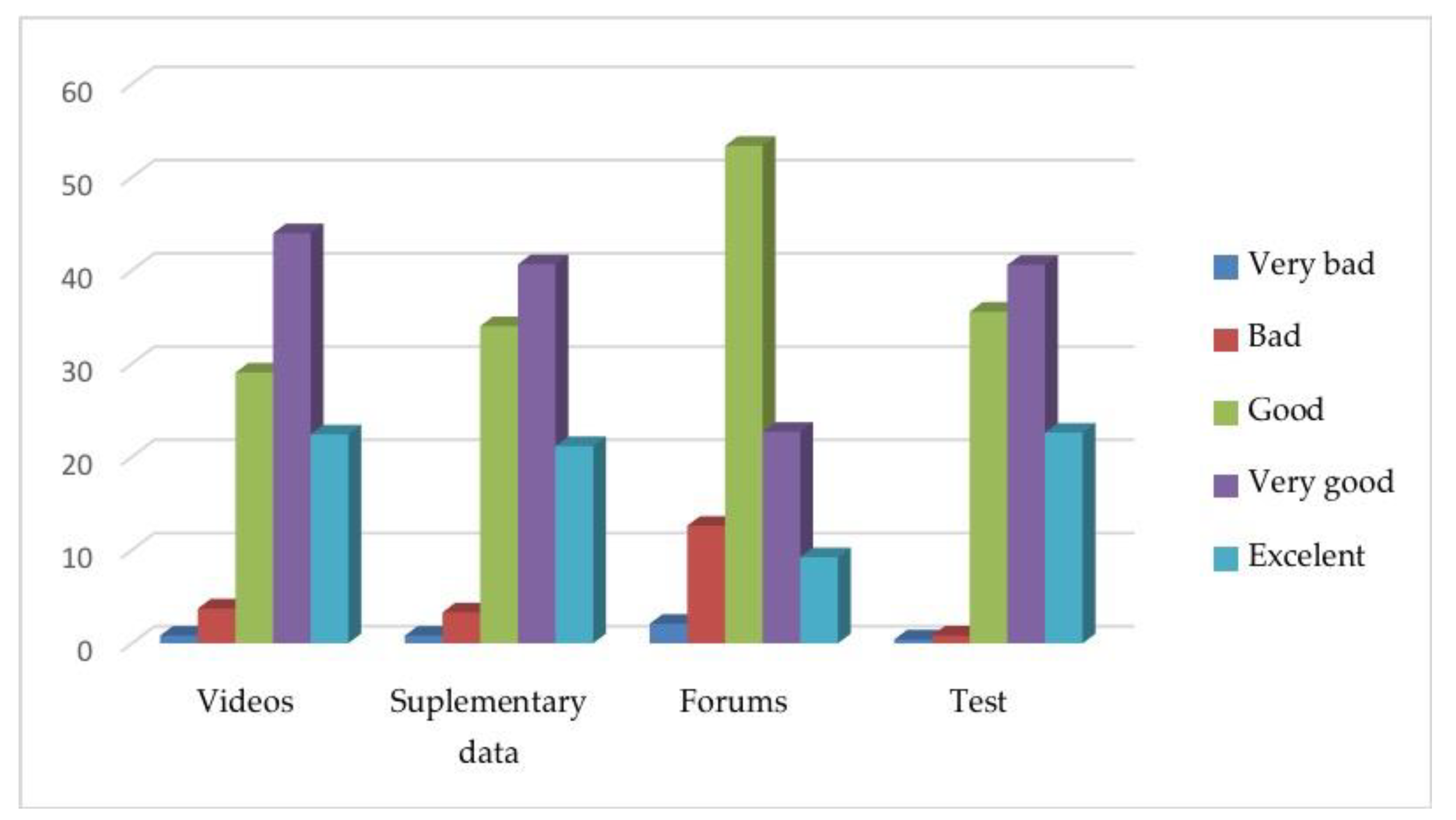
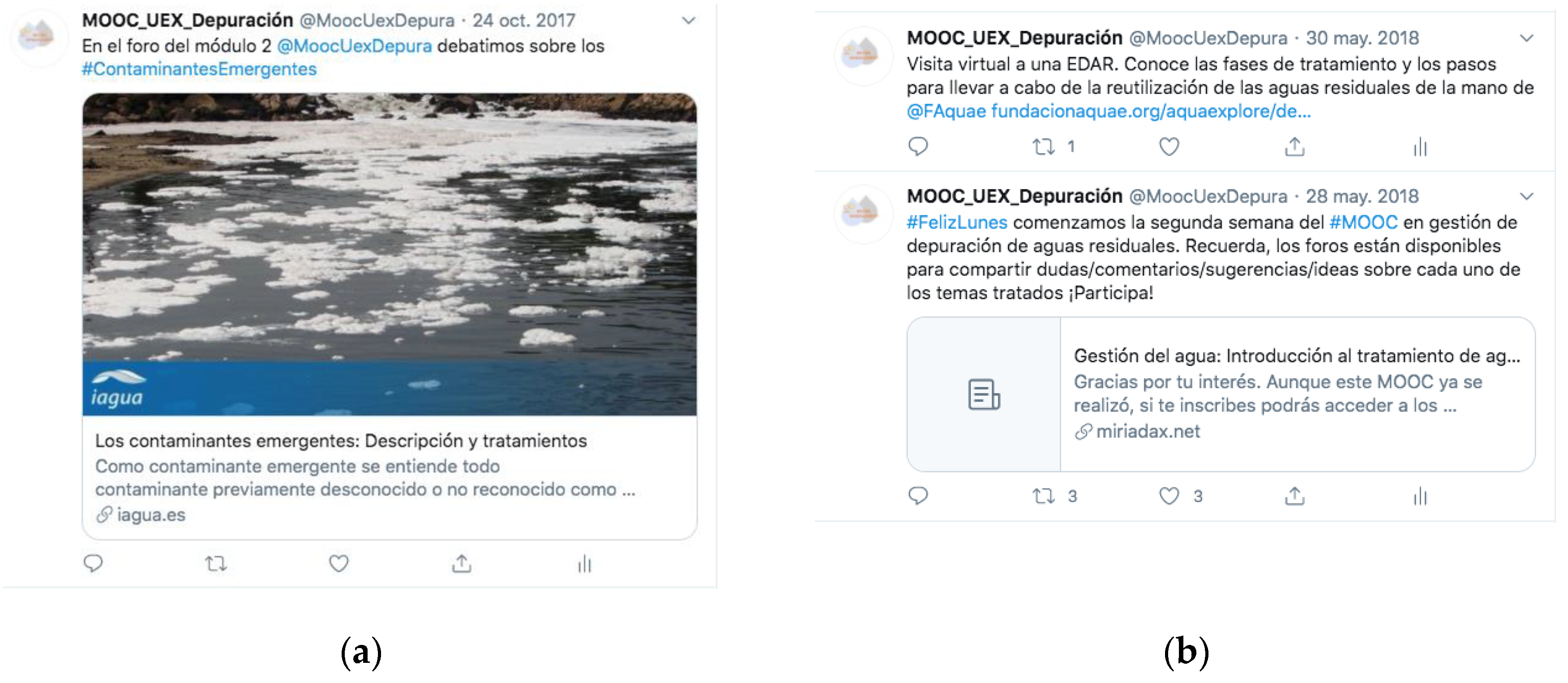
| MOOC Pillars | Factors | Reference |
|---|---|---|
| Student autonomy | Academic skills Previous experience | Ruiz-Palomero et al. [11] Kennedy et al. [19] Lee et al. [20] |
| Direct and progressive lessons | Course design | Guo et al. [13] Callejo et al. [21] |
| Social support | Feedback Social presence Social support | Park et al. [14] Panigrahi and Srvastava [15] Jiang at al. [16] |
| Data | First Edition | Second Edition | Third Edition 1 |
|---|---|---|---|
| Start dates | 16 October 2017 | 21 May 2018 | 22 April 2020 |
| Enrolled students | 1508 | 2331 | 555 |
| Starting rate | 63.66% | 39.36% | 74.59% |
| Completion rate | 23.93% | 36.80% | 45.41% |
| Questionnaires | 1520 | 843 | 323 |
| Education Level | First Edition | Second Edition | Third Edition |
|---|---|---|---|
| Secondary education | 7.72% | 6.67% | 8.0% |
| Undergraduates | 23.02% | 27.0% | 20.4% |
| Graduates | 44.67% | 59.4% | 45.3% |
| Postgraduates | 24.18% | 6.77% | 25.0% |
| Any studies | 0.41% | - | 1.3% |
| Questions | Yes | No |
|---|---|---|
| Have you ever done online training before? | 42.6% | 57.4% |
| Do you have previous knowledge on the subject of the course? | 72.7% | 22.3% |
| Twitter Analytics | First Edition | Second Edition | |
|---|---|---|---|
| Total impressions. | 9500 | 8200 | |
| Impressions per day. | 272 | 245 | |
| Engagement rate. | 1.6% | 1.5% | |
| Types of tweets. | Promotional. | 8 | 4 |
| Motivational. | 6 | 6 | |
| Complementary information. | 7 | 9 | |
| Incidents. | - | 1 | |
© 2020 by the authors. Licensee MDPI, Basel, Switzerland. This article is an open access article distributed under the terms and conditions of the Creative Commons Attribution (CC BY) license (http://creativecommons.org/licenses/by/4.0/).
Share and Cite
Gómez-Llanos, E.; Durán-Barroso, P. Learning Design Decisions in Massive Open Online Courses (MOOC) Applied to Higher Education in Civil-Engineering Topics. Sustainability 2020, 12, 8430. https://doi.org/10.3390/su12208430
Gómez-Llanos E, Durán-Barroso P. Learning Design Decisions in Massive Open Online Courses (MOOC) Applied to Higher Education in Civil-Engineering Topics. Sustainability. 2020; 12(20):8430. https://doi.org/10.3390/su12208430
Chicago/Turabian StyleGómez-Llanos, Eva, and Pablo Durán-Barroso. 2020. "Learning Design Decisions in Massive Open Online Courses (MOOC) Applied to Higher Education in Civil-Engineering Topics" Sustainability 12, no. 20: 8430. https://doi.org/10.3390/su12208430
APA StyleGómez-Llanos, E., & Durán-Barroso, P. (2020). Learning Design Decisions in Massive Open Online Courses (MOOC) Applied to Higher Education in Civil-Engineering Topics. Sustainability, 12(20), 8430. https://doi.org/10.3390/su12208430





